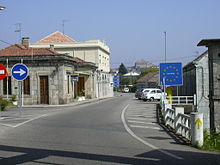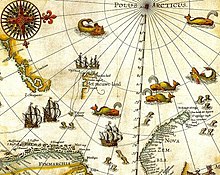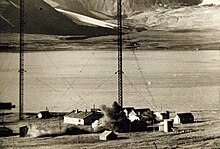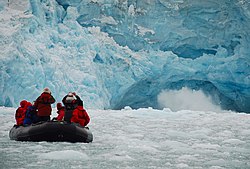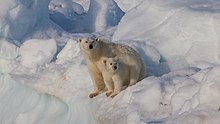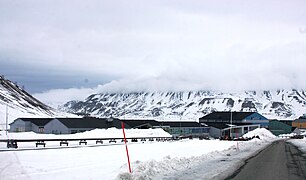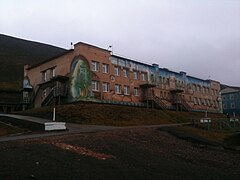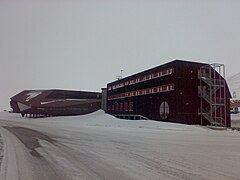From Wikipedia, the free encyclopedia
Svalbard (
SVAHL-bar,
prior to 1925 known as
Spitsbergen, or
Spitzbergen, is a
Norwegian archipelago in the
Arctic Ocean. Situated north of
mainland Europe, it is about midway between continental Norway and the
North Pole. The islands of the group range from
74° to
81° north latitude, and from
10° to
35° east longitude. The largest island is
Spitsbergen, followed by
Nordaustlandet and
Edgeøya. While part of the Kingdom of Norway since 1925, Svalbard is not part of geographical
Norway proper; administratively, the archipelago is not part of any
Norwegian county, but forms an
unincorporated area administered by a
governor appointed by the Norwegian government, and a special jurisdiction subject to the
Svalbard Treaty that is, unlike Norway proper, outside of the
Schengen Area, the
Nordic Passport Union and the
European Economic Area.
Since 2002, Svalbard's main settlement,
Longyearbyen, has had an
elected local government, somewhat similar to
mainland municipalities. Other settlements include the Russian mining community of
Barentsburg, the research station of
Ny-Ålesund, and the mining outpost of
Sveagruva. Other settlements are farther north, but are populated only by rotating groups of researchers.
The islands were first used as a
whaling base by whalers who sailed far north in pursuit of whales for
blubber in the 17th and 18th centuries, after which they were abandoned.
Coal mining started at the beginning of the 20th century, and several permanent communities were established. The
Svalbard Treaty of 1920 recognizes Norwegian
sovereignty, and the 1925
Svalbard Act made Svalbard a full part of the Kingdom of Norway. They also established Svalbard as a
free economic zone and a
demilitarized zone. The Norwegian
Store Norske and the Russian
Arktikugol remain the only mining companies in place. Research and tourism have become important supplementary industries, with the
University Centre in Svalbard (UNIS) and the
Svalbard Global Seed Vault playing critical roles. No roads connect the settlements; instead
snowmobiles, aircraft and boats serve inter-community transport.
Svalbard Airport, Longyear serves as the main gateway.
The archipelago features an
Arctic climate, although with significantly higher temperatures than other areas at the same latitude. The
flora take advantage of the long period of
midnight sun to compensate for the
polar night. Svalbard is a breeding ground for many
seabirds, and also features
polar bears,
reindeer, the
Arctic fox, and certain
marine mammals.
Seven national parks
and twenty-three nature reserves cover two-thirds of the archipelago,
protecting the largely untouched, yet fragile, natural environment.
Approximately 60% of the archipelago is covered with
glaciers, and the islands feature many mountains and
fjords.
Svalbard and Jan Mayen are collectively assigned the
ISO 3166-1 alpha-2
country code "SJ". Both areas are administered by Norway, though they
are separated by a distance of over 950 kilometres (590 miles; 510
nautical miles) and have very different administrative structures.
Etymology
The name Svalbard comes from an older native name for the archipelago,
Svalbarð, composed of the well-attested Old Norse words
svalr ("cold") and
barð ("edge; ridge, turf, beard"). The name
Spitsbergen originated with Dutch navigator and explorer
Willem Barentsz, who described the "pointed mountains" or, in Dutch,
spitse bergen
that he saw on the west coast of the main island, Spitsbergen. Barentsz
did not recognize that he had discovered an archipelago, and
consequently the name
Spitsbergen long remained in use both for the main island and for the archipelago as a whole.
Geography
The Svalbard Treaty of 1920 defines Svalbard as all islands, islets and
skerries from 74° to 81° north latitude, and from 10° to 35° east longitude. The land area is 61,022 km
2
(23,561 sq mi), and dominated by the island of Spitsbergen, which
constitutes more than half the archipelago, followed by Nordaustlandet
and Edgeøya. All settlements are located on Spitsbergen, except the meteorological outposts on
Bjørnøya and
Hopen.
The Norwegian state took possession of all unclaimed land, or 95.2% of
the archipelago, at the time the Svalbard Treaty entered into force;
Store Norske, a Norwegian coal mining company, owns 4%,
Arktikugol, a Russian coal mining company, owns 0.4%, while other private owners hold 0.4%.
Since Svalbard is located north of the
Arctic Circle, it experiences
midnight sun in summer and
polar night
in winter. At 74° north, the midnight sun lasts 99 days and polar night
84 days, while the respective figures at 81° are 141 and 128 days. In
Longyearbyen, midnight sun lasts from 20 April until 23 August, and polar night lasts from 26 October to 15 February. In winter, the combination of
full moon and reflective snow can give additional light.
Due to the Earth's tilt and the high latitude, Svalbard has extensive
twilights. Longyearbyen sees the first and last day of polar night
having seven and a half hours of twilight, whereas the perpetual light
lasts for two weeks longer than the midnight sun.
On the summer solstice, the sun bottoms out at 12° sun angle in the
middle of the night, being much higher during night than in mainland
Norway's polar light areas. However, the daytime strength of the sun remains as low as 35°.
Glacial ice covers 36,502 km
2 (14,094 sq mi) or 60% of Svalbard; 30% is barren rock while 10% is vegetated. The largest glacier is
Austfonna (8,412 km
2 or 3,248 sq mi) on Nordaustlandet, followed by
Olav V Land and
Vestfonna. During summer, it is possible to ski from
Sørkapp in the south to the north of Spitsbergen, with only a short distance not being covered by snow or glacier.
Kvitøya is 99.3% covered by glacier.
The landforms of Svalbard were created through
repeated ice ages, when glaciers cut the former plateau into fjords, valleys, and mountains. The tallest peak is
Newtontoppen (1,717 m or 5,633 ft), followed by
Perriertoppen (1,712 m or 5,617 ft),
Ceresfjellet (1,675 m or 5,495 ft),
Chadwickryggen (1,640 m or 5,380 ft), and
Galileotoppen (1,637 m or 5,371 ft). The longest fjord is
Wijdefjorden (108 km or 67 mi), followed by
Isfjorden (107 km or 66 mi),
Van Mijenfjorden (83 km or 52 mi),
Woodfjorden (64 km or 40 mi), and
Wahlenbergfjorden (46 km or 29 mi). Svalbard is part of the
High Arctic Large Igneous Province, and experienced Norway's strongest earthquake on 6 March 2009, which hit a magnitude of 6.5.
History
Svalbard,
here mapped for the first time, is indicated as "Het Nieuwe Land"
(Dutch for "the New Land"), center-left. Portion of 1599 map of Arctic
exploration by
Willem Barentsz.
Dutch discovery, exploration, and mapping of a terra nullius
The Dutchman
Willem Barentsz
made the first discovery of the archipelago in 1596, when he sighted
the coast of the island of Spitsbergen while searching for the
Northern Sea Route.
The first recorded landing on the islands of Svalbard dates to 1604, when an English ship landed at
Bjørnøya, or Bear Island, and started hunting
walrus. Annual expeditions soon followed, and Spitsbergen became a base for hunting the
bowhead whale from 1611.
Because of the lawless nature of the area, English, Danish, Dutch, and
French companies and authorities tried to use force to keep out other
countries' fleets.
17th–18th centuries
The whaling station of the Amsterdam chamber of the Northern Company in
Smeerenburg, by
Cornelis de Man (1639), but based on a painting of a
Dansk hvalfangststation (Danish whaling station) by A.B.R. Speeck (1634), which represented the Danish station in Copenhagen Bay (Kobbefjorden)
Smeerenburg was one of the first settlements, established by the Dutch in 1619.
Smaller bases were also built by the English, Danish, and French. At
first the outposts were merely summer camps, but from the early 1630s, a
few individuals started to
overwinter. Whaling at Spitsbergen lasted until the 1820s, when the Dutch, British, and Danish whalers moved elsewhere in the Arctic. By the late 17th century,
Russian hunters arrived; they overwintered to a greater extent and hunted land mammals such as the polar bear and fox.
19th century
After the
Anglo-Russian War in 1809, Russian activity on Svalbard diminished, and ceased by the 1820s.
Norwegian hunting—mostly for walrus—started in the 1790s. The first
Norwegian citizens to reach Spitsbergen proper were a number of Coast
Sámi people from the
Hammerfest region, who were hired as part of a Russian crew for an expedition in 1795. Norwegian whaling was abandoned about the same time as the Russians left, but whaling continued around Spitsbergen until the 1830s, and around Bjørnøya until the 1860s.
20th century
Svalbard Treaty and Norwegian sovereignty
By the 1890s, Svalbard had become a destination for Arctic tourism,
coal deposits had been found and the islands were being used as a base
for
Arctic exploration. The first mining was along Isfjorden by Norwegians in 1899; by 1904, British interests had established themselves in
Adventfjorden and started the first all-year operations. Production in Longyearbyen, by American interests, started in 1908;
and Store Norske established itself in 1916, as did other Norwegian
interests during the war, in part by buying American interests.
Discussions to establish the sovereignty of the archipelago commenced in the 1910s, but were interrupted by
World War I. On 9 February 1920, following the
Paris Peace Conference, the
Svalbard Treaty
was signed, granting full sovereignty to Norway. However, all signatory
countries were granted non-discriminatory rights to fishing, hunting,
and mineral resources. The treaty took effect on 14 August 1925, at the same time as the
Svalbard Act regulated the archipelago and the first
governor,
Johannes Gerckens Bassøe, took office.
The archipelago has traditionally been known as Spitsbergen, and the
main island as West Spitsbergen. From the 1920s, Norway renamed the
archipelago Svalbard, and the main island became Spitsbergen. Kvitøya, Kong Karls Land, Hopen, and Bjørnøya were not regarded as part of the Spitsbergen archipelago. Russians have traditionally called the archipelago Grumant (
Грумант). The
Soviet Union retained the name Spitsbergen (
Шпицберген) to support undocumented claims that Russians were the first to discover the island. In 1928, Italian explorer
Umberto Nobile and the crew of the airship
Italia crashed on the icepack off the coast of
Foyn Island. The subsequent rescue attempts were covered extensively in the press and Svalbard received short-lived fame as a result.
Second World War
Demolition of the wireless station during Operation Gauntlet in 1941
Svalbard, known to both British and Germans as Spitsbergen, was little affected by the
German invasion of Norway in April 1940. The settlements continued to operate as before, mining coal and monitoring the weather.
In July 1941, following the German invasion of the Soviet Union, the
Royal Navy
reconnoitred the islands with a view to using them as a base of
operations to facilitate sending supplies to north Russia, but the idea
was rejected as too impractical.
Instead, with the agreement of the Soviets and the Norwegian government
in exile, in August 1941 the Norwegian and Soviet settlements on
Svalbard were evacuated, and facilities there destroyed, in
Operation Gauntlet.
However the Norwegian government in exile decided it would be important
politically to establish a garrison in the islands, which was done in
May 1942 during
Operation Fritham.
Meanwhile, the Germans had responded to the destruction of
weather station by establishing a reporting station of their own,
codenamed
"Banso", in October 1941.
This was chased away in November by a visit from four British warships,
but later returned. A second station, "Knospel", was established at
Ny Alesund in 1941, remaining until 1942. In May 1942, after the arrival of the Fritham force, the German unit at Banso was evacuated.
In September 1943 in
Operation Zitronella a German task force, which included the battleship
Tirpitz, was sent to attack the garrison and destroy the settlements at Longyearbyen and Barentsburg.
This was achieved, but had little long-term effect: after their
departure the Norwegians returned and re-established their presence.
In September 1944, the Germans set up their last weather station,
Operation Haudegen
in NordOstLand; this remained functioning until after the German
surrender. On 4 September 1945, the soldiers were picked up by a
Norwegian seal hunting vessel and surrendered to its captain. This group
of men were the last German troops to surrender after the Second World
War.
After the war, the Soviet Union proposed common Norwegian and
Soviet administration and military defence of Svalbard. This was
rejected in 1947 by Norway, which two years later joined
NATO. The Soviet Union retained high civilian activity on Svalbard, in part to ensure that the archipelago was not used by NATO.
Post-war
After the war, Norway re-established operations at Longyearbyen and Ny-Ålesund, while the Soviet Union established mining in Barentsburg,
Pyramiden and
Grumant.
The mine at Ny-Ålesund had several fatal accidents, killing 71 people
while it was in operation from 1945 to 1954 and from 1960 to 1963. The
Kings Bay Affair, caused by the 1962 accident killing 21 workers, forced
Gerhardsen's Third Cabinet to resign. From 1964, Ny-Ålesund became a research outpost, and a facility for the
European Space Research Organisation. Petroleum test drilling was started in 1963 and continued until 1984, but no commercially viable fields were found. From 1960, regular charter flights were made from the mainland to a field at
Hotellneset; in 1975, Svalbard Airport, Longyear opened, allowing year-round services.
During the
Cold War,
the Soviet Union comprised about two-thirds of the population on the
islands (Norwegians making up the remaining third) with the population
of the archipelago slightly under 4,000. Russian activity has diminished considerably since then, falling from 2,500 to 450 people from 1990 to 2010. Grumant was closed after it was depleted in 1962.
Pyramiden was closed in 1998. Coal exports from Barentsburg ceased in 2006 because of a fire, but resumed in 2010. The Russian community has also experienced two air accidents,
Vnukovo Airlines Flight 2801, which killed 141 people, and the
Heerodden helicopter accident, which killed three people.
Longyearbyen remained purely a company town until 1989 when
utilities, culture, and education was separated into Svalbard
Samfunnsdrift. In 1993, it was sold to the national government and the University Centre was established. Through the 1990s, tourism increased and the town developed an economy independent of Store Norske and the mining. Longyearbyen was incorporated on 1 January 2002, receiving a community council.
Population
Demographics
In 2016, Svalbard had a population of 2,667, of which 423 were
Russian and Ukrainian, 10 Polish, and 322 non-Norwegians living in
Norwegian settlements.
The largest non-Norwegian groups in Longyearbyen in 2005 were from
Russia, Ukraine, Poland, Germany, Sweden, Denmark, and Thailand.
Settlements
Longyearbyen
is the largest settlement on the archipelago, the seat of the governor
and the only town to be incorporated. The town features a hospital,
primary and secondary school,
university, sports center with a swimming pool, library, culture center, cinema, bus transport, hotels, a bank, and several museums. The newspaper
Svalbardposten is published weekly. Only a small fraction of the mining activity remains at Longyearbyen; instead, workers commute to
Sveagruva (or Svea) where Store Norske operates a mine. Sveagruva is a
dormitory town, with workers commuting from Longyearbyen weekly.
Ny-Ålesund is a permanent settlement based entirely around research. Formerly a mining town, it is still a
company town operated by the Norwegian state-owned
Kings Bay.
While there is some tourism there, Norwegian authorities limit access
to the outpost to minimize impact on the scientific work. Ny-Ålesund has a winter population of 35 and a summer population of 180.
The
Norwegian Meteorological Institute
has outposts at Bjørnøya and Hopen, with respectively ten and four
people stationed. Both outposts can also house temporary research staff. Poland operates the
Polish Polar Station at
Hornsund, with ten permanent residents.
The abandoned Soviet mining town of
Pyramiden
Barentsburg is the only permanently inhabited Russian settlement after
Pyramiden
was abandoned in 1998. It is a company town: all facilities are owned
by Arktikugol, which operates a coal mine. In addition to the mining
facilities, Arktikugol has opened a hotel and souvenir shop, catering
for tourists taking day trips or hikes from Longyearbyen.
The village features facilities such as a school, library, sports
center, community center, swimming pool, farm, and greenhouse. Pyramiden
features similar facilities; both are built in typical post-World War
II Soviet architectural and planning style and contain the world's two
most northerly
Lenin statues and other
socialist realism artwork. As of 2013,
a handful of workers are stationed in the largely abandoned Pyramiden
to maintain the infrastructure and run the hotel, which has been
re-opened for tourists.
Religion
Politics
The
Svalbard Treaty of 1920 established full Norwegian sovereignty over the archipelago. The islands are, unlike the
Norwegian Antarctic Territory, a part of the Kingdom of Norway and not a
dependency.
The treaty came into effect in 1925, following the Svalbard Act. All
forty signatory countries of the treaty have the right to conduct
commercial activities on the archipelago without discrimination,
although all activity is subject to Norwegian legislation. The treaty
limits Norway's right to collect taxes to that of financing services on
Svalbard. Therefore, Svalbard has a lower
income tax than mainland Norway, and there is no
value added tax. There is a separate budget for Svalbard to ensure compliance. Svalbard is a
demilitarized zone,
as the treaty prohibits the establishment of military installations.
Norwegian military activity is limited to fishery surveillance by the
Norwegian Coast Guard as the treaty requires Norway to protect the natural environment.
There are no restrictions on foreigners migrating in, and hence no
visa requirement.
The Svalbard Act established the institution of the Governor of Svalbard (
Norwegian:
Sysselmannen), who holds the responsibility as both
county governor and
chief of police, as well as holding other authority granted from the executive branch. Duties include
environmental policy,
family law,
law enforcement,
search and rescue,
tourism management, information services, contact with foreign
settlements, and judge in some areas of maritime inquiries and judicial
examinations—albeit never in the same cases as acting as police. Since 2015,
Kjerstin Askholt has been governor; she is assisted by a staff of 26 professionals. The institution is subordinate to the
Ministry of Justice and the Police, but reports to other ministries in matters within their portfolio.
Since 2002,
Longyearbyen Community Council has had many of the same responsibilities of a
municipality, including utilities, education, cultural facilities, fire department, roads, and ports.
No care or nursing services are available, nor is welfare payment
available. Norwegian residents retain pension and medical rights through
their mainland municipalities. The hospital is part of
University Hospital of North Norway, while the airport is operated by state-owned
Avinor. Ny-Ålesund and Barentsburg remain
company towns with all infrastructure owned by Kings Bay and Arktikugol, respectively. Other public offices with presence on Svalbard are the
Norwegian Directorate of Mining, the
Norwegian Polar Institute, the
Norwegian Tax Administration, and the
Church of Norway. Svalbard is subordinate to
Nord-Troms District Court and
Hålogaland Court of Appeal, both located in
Tromsø.
In September 2010, a treaty was made between Russia and Norway fixing the boundary between the Svalbard archipelago and the
Novaya Zemlya archipelago.
Increased interest in petroleum exploration in the Arctic raised
interest in a resolution of the dispute. The agreement takes into
account the relative positions of the archipelagos, rather than being
based simply on northward extension of the continental border of Norway
and Russia.
Economy
The three main industries on Svalbard are
coal mining,
tourism, and
research.
In 2007, there were 484 people working in the mining sector, 211 people
working in the tourism sector, and 111 people working in the education
sector. The same year, the mining gave a revenue of 2.008 billion
Norwegian kroner (US$227,791,078), tourism 317 million kroner ($35,967,202), and research 142 million kroner ($16,098,404). In 2006, the average income for economically active people was 494,700 kroner; 23% higher than on the mainland.
Almost all housing is owned by the various employers and institutions
and rented to their employees; there are only a few privately owned
houses, most of which are recreational cabins. Because of this, it is
nearly impossible to live on Svalbard without working for an established
institution.
Since the resettlement of Svalbard in the early 20th century, coal mining has been the dominant commercial activity.
Store Norske Spitsbergen Kulkompani, a subsidiary of the
Norwegian Ministry of Trade and Industry,
operates Svea Nord in Sveagruva and Mine 7 in Longyearbyen. The former
produced 3.4 million tonnes in 2008, while the latter uses 35% of its
output to fuel the Longyearbyen Power Station. Since 2007, there has not
been any significant mining by the Russian state-owned Arktikugol in
Barentsburg. There have previously been performed test drilling for
petroleum on land, but these did not give satisfactory results for
permanent operation. The Norwegian authorities do not allow offshore
petroleum activities for environmental reasons, and the land formerly
test-drilled on have been protected as natural reserves or national
parks. In 2011, a 20-year plan to develop offshore oil and gas resources around Svalbard was announced.
Svalbard has historically been a base for both
whaling and
fishing. Norway claimed a 200-nautical-mile (370 km; 230 mi)
exclusive economic zone (EEZ) around Svalbard in 1977, with 31,688 square kilometres (12,235 sq mi) of
internal waters and 770,565 square kilometres (297,517 sq mi) of EEZ. Norway retains a restrictive fisheries policy in the zone, and the claims are disputed by Russia.
Tourism is focused on the environment and is centered on Longyearbyen.
Activities include hiking, kayaking, walks through glacier caves, and
snowmobile
and dog-sled safari. Cruise ships generate a significant portion of the
traffic, including both stops by offshore vessels and expeditionary
cruises starting and ending in Svalbard. Traffic is strongly
concentrated between March and August; overnights have quintupled from
1991 to 2008, when there were 93,000 guest-nights.
Research on Svalbard centers on Longyearbyen and Ny-Ålesund, the
most accessible areas in the high Arctic. The treaty grants permission
for any nation to conduct research on Svalbard, resulting in the
Polish Polar Station and the Chinese
Arctic Yellow River Station, plus Russian facilities in Barentsburg. The
University Centre in Svalbard
in Longyearbyen offers undergraduate, graduate, and postgraduate
courses to 350 students in various arctic sciences, particularly
biology,
geology, and
geophysics.
Courses are provided to supplement studies at the mainland
universities; there are no tuition fees and courses are held in English,
with Norwegian and international students equally represented.
The
Svalbard Global Seed Vault is a
seedbank
to store seeds from as many of the world's crop varieties and their
botanical wild relatives as possible. A cooperation between the
government of Norway and the
Global Crop Diversity Trust,
the vault is cut into rock near Longyearbyen, keeping it at a natural
−6 °C (21 °F) and refrigerating the seeds to −18 °C (0 °F).
One source of income for the area was, until 2015, visiting
cruise ships. The Norwegian government became concerned about large
numbers of cruise ship passengers suddenly landing at small settlements
such as Ny-Ålesund, which is conveniently close to the
barren-yet-picturesque
Magdalena Fjord.
With the increasing size of the larger ships, up to 2,000 people can
potentially appear in a community that normally numbers less than 40. As
a result, the government severely restricted the size of cruise ships
that may visit.
Transport
Snowmobiles are an important mode of transport in Svalbard, such as here at Longyearbyen.
Within Longyearbyen, Barentsburg, and Ny-Ålesund, there are road systems, but they do not connect with each other.
Off-road
motorized transport is prohibited on bare ground, but snowmobiles are
used extensively during winter—both for commercial and recreational
activities. Transport from Longyearbyen to Barentsburg (45 km or 28 mi)
and Pyramiden (100 km or 62 mi) is possible by snowmobile in winter, or
by ship all year round. All settlements have ports and Longyearbyen has a
bus system.
Svalbard Airport, Longyear, located 3 kilometres (2 mi) from Longyearbyen, is the only airport offering air transport off the archipelago.
Scandinavian Airlines has daily scheduled services to
Tromsø and
Oslo. Low-cost carrier
Norwegian Air Shuttle
also has a service between Oslo and Svalbard, operating three or four
times a week; there are also irregular charter services to Russia.
Finnair operated service from
Helsinki,
operating three times per week between June and August 2016, but
Norwegian authorities did not allow this route, citing the 1978
bilateral agreement on air traffic between Finland and Norway.
Lufttransport provides regular corporate charter services from Longyearbyen to
Ny-Ålesund Airport and
Svea Airport for Kings Bay and Store Norske; these flights are generally not available to the public. There are
heliports
in Barentsburg and Pyramiden, and helicopters are frequently used by
the governor and to a lesser extent the mining company Arktikugol.
Climate
The climate of Svalbard is dominated by its high latitude, with the
average summer temperature at 4 to 6 °C (39 to 43 °F) and January
averages at −16 to −12 °C (3 to 10 °F).
The
West Spitsbergen Current, the northernmost branch of the
North Atlantic Current
system, moderates Svalbard's temperatures, particularly during winter.
Winter temperatures in Svalbard are up to 2 °C (4 °F) higher than those
at similar latitudes in Russia and Canada. The warm Atlantic water keeps
the surrounding waters open and navigable most of the year. The
interior fjord areas and valleys, sheltered by the mountains, have
larger temperature differences than the coast, giving about 20 °C
(36 °F) warmer summer temperatures and 3 °C (5 °F) colder winter
temperatures. On the south of Spitsbergen, the temperature is slightly
higher than further north and west. During winter, the temperature
difference between south and north is typically 5 °C (9 °F), and about
3 °C (5 °F) in summer.
Bear Island has average temperatures even higher than the rest of the archipelago.
Svalbard is where cold
polar air
from the north and mild, wet sea air from the south meet, creating low
pressure, changeable weather and strong winds, particularly in winter;
in January, a strong breeze is registered 17% of the time at
Isfjord Radio, but only 1% of the time in July. In summer, particularly away from land,
fog is common, with visibility under 1 kilometre (0.6 mi) registered
20% of the time in July and 1% of the time in January, at Hopen and
Bjørnøya.
Precipitation is frequent, but falls in small quantities, typically
less than 400 millimetres (16 in) per year in western Spitsbergen. More
rain falls on the uninhabited east side, where there can be more than
1,000 millimetres (39 in).
2016 was the warmest year on record at Svalbard Airport, with a
remarkable mean temperature of 0.0 °C (32.0 °F), 7.5 °C (13.5 °F) above
the 1961–90 average, and more comparable to a location at the
arctic circle.
The coldest temperature of the year was as high as −18 °C (0 °F),
warmer than the mean minimum in a normal January, February or March. In
the same year, the number of days when there was rainfall equalled the
number of days when there was snowfall, a significant deviation from the
usual pattern whereby there would be at least twice as many snow days.
Global warming
has resulted in noticeable climatic changes on Svalbard. Between 1970
and 2020, the average temperature on Svalbard rose by 4 degrees Celsius,
and in the winter months by 7 degrees.
On July 25, 2020, a new record temperature of 21.7 degrees Celsius was
measured for the Svalbard archipelago, which is also the highest
temperature ever recorded in the European part of the Arctic; In
addition, temperatures of over 20 degrees were measured four days in a
row in July 2020. As in large parts of the Arctic, the
ice–albedo feedback
effects can also be noticed on Svalbard: Due to the substantial ice
melt, ice surfaces are transformed into open water, the darker surface
of which absorbs more solar energy instead of reflecting it back; as a
result, these waters heat up and further ice in the area melts faster
and faster, creating more open waters, etc. A temperature increase of
between 7 and 10 degrees is expected on Svalbard by the end of the
century.
Nature
Polar bears are the iconic symbol of Svalbard, and one of the main tourist attractions.
The animals are protected and people moving outside the settlements are
required to have appropriate scare devices to ward off attacks. They
are also advised to carry a firearm for use as a last resort. A British schoolboy was killed by a polar bear in 2011. In July 2018, a polar bear was shot dead after it attacked and injured a polar bear guard leading tourists off a cruise ship. Svalbard and
Franz Joseph Land share a common population of 3,000 polar bears, with
Kong Karls Land being the most important breeding ground.
The
Svalbard reindeer (
R. tarandus platyrhynchus) is a distinct subspecies; although it was previously almost extinct, it can be legally hunted (as can Arctic fox). There are limited numbers of domesticated animals in the Russian settlements.
Svalbard has
permafrost and
tundra, with both low, middle, and high
Arctic vegetation. 165 species of plants have been found on the archipelago. Only those areas which defrost in the summer have vegetations, which accounts for about 10% of the archipelago. Vegetation is most abundant in Nordenskiöld Land, around Isfjorden and where affected by
guano. While there is little precipitation, giving the archipelago a
steppe climate, plants still have good access to water because the cold climate reduces evaporation. The growing season is very short, and may last only a few weeks.
Education
Longyearbyen School serves ages 6–18. It is the primary/secondary school in the
northernmost location on Earth. Once pupils reach ages 16 or 17, most families move to mainland Norway.
Barentsburg has its own school serving the Russian community; by 2014 it had three teachers, and its welfare funds had declined. A primary school served the community of
Pyramiden in the pre-1998 period.
Sports
Association football
is the most popular sport in Svalbard. There are three football pitches
(one at Barentsburg), but no stadiums because of the small population.
There is also an indoor hall adopted for multiple sports including
indoor football.


